Cake cutting guides are essential for achieving even slices and maintaining presentation. They help ensure consistent portion sizes and visual appeal for any occasion, from weddings to casual gatherings.
1.1 Importance of Proper Cake Cutting
Proper cake cutting is crucial for maintaining presentation, consistency, and professionalism. Even slices ensure visual appeal, making the cake more enjoyable for guests. It also guarantees fair portion distribution, preventing some slices from being larger than others. Proper techniques prevent the cake from crumbling or smearing, preserving its structural integrity. For professional bakers and event planners, precise cutting reflects skill and attention to detail, enhancing the overall dining experience. Whether for weddings or casual gatherings, clean, even slices elevate the cake’s appeal and satisfaction.
1.2 Brief Overview of Cake Cutting Techniques
Cake cutting techniques involve tools like serrated knives or dental floss for clean slices. Chilling the cake firms it, while warming the knife ensures smooth cuts. Marking slices with light pressure prevents uneven portions. Using a cake stand enhances stability. Alternatives like fishing line offer precise cuts. Techniques vary for round, square, or sheet cakes, ensuring even distribution. Proper methods maintain presentation, prevent crumbs, and deliver consistent serving sizes, making every slice visually appealing and professionally cut.

Essential Tools for Cutting Cake
Key tools for cutting cake include serrated knives, cake stands, and cutting boards. Optional tools like dental floss or fishing line offer unique ways to achieve precise slices;
2.1 Best Knives for Cutting Cake
The best knife for cutting cake is a serrated tomato knife, as it glides through frosting and layers cleanly. A 5–8 inch serrated blade is ideal for precise cuts. Avoid using straight-edged knives, as they can compress the cake and create uneven slices. For larger cakes, a long serrated knife ensures smooth, even cuts. If a serrated knife isn’t available, a sharp, heated knife can also work well. Always wipe the knife between slices to prevent frosting buildup and ensure clean cuts.
2.2 Using a Cake Stand or Cutting Board
A cake stand or cutting board is crucial for stable and efficient cake cutting. A stand elevates the cake, making it easier to access all sides and ensuring even slicing. For layered cakes, a sturdy cutting board with a non-slip mat prevents movement during cutting. Always place the cake on a clean, flat surface to maintain control and avoid accidents. Using a stand or board also helps in presenting the cake attractively before and after slicing, enhancing the overall serving experience for guests.
2.3 Alternative Tools: Dental Floss or Fishing Line

Dental floss or fishing line can be surprisingly effective for cutting cakes, especially layered or delicate ones. These tools allow for precise, clean cuts without applying heavy pressure, reducing crumbs and smears. For best results, use sturdy, unscented floss or a strong fishing line. Gently press the tool through the cake along pre-marked guidelines to ensure even slices. This method is particularly useful for soft or tiered cakes, providing smooth, professional-looking results with minimal effort and no special equipment required.
Techniques for Cutting Even Cake Slices
Chilling the cake, using a warm knife, and wiping it between cuts ensures clean, even slices and prevents crumbs from spreading, maintaining a professional appearance.
3.1 Chilling the Cake Before Cutting
Chilling the cake before cutting is a simple yet effective technique to ensure clean, even slices. Place the cake in the refrigerator for about 10 to 15 minutes to firm up the frosting and layers. A chilled cake is less likely to crumble or smear, making it easier to slice neatly. Avoid freezing, as this can make the cake too hard to cut smoothly. Once chilled, remove the cake and let it sit for a few minutes before slicing for the best results.
3.2 Using a Warm Knife for Smoother Cuts
A warm knife is key to achieving smooth, clean cuts. Run the blade under hot water, dry it thoroughly, and slice while the knife is still warm. This melts the frosting slightly, allowing the knife to glide through the cake without dragging or smearing. Repeat heating and drying between slices for consistent results. A warm knife ensures even cuts and preserves the cake’s appearance, making it ideal for both layered and frosted cakes. This technique is especially useful for large or tiered cakes served at events or weddings.
3.3 Wiping the Knife Between Slices
Wiping the knife between slices is crucial for clean, precise cuts. After each slice, use a kitchen towel or sponge to remove accumulated frosting and crumbs. This prevents the knife from dragging debris through the cake, ensuring smooth, even cuts. A clean knife also reduces the risk of smearing frosting or tearing the cake layers. Regular wiping maintains the knife’s efficiency and helps achieve professional-looking results, especially for layered or frosted cakes. This simple step enhances both the appearance and consistency of your cake slices.
Cutting Guides for Different Cake Shapes
This section provides cutting guides for round, square, and sheet cakes, ensuring precise and uniform slices for every occasion. Learn how to achieve perfect portion sizes and presentation.

4.1 Round Cake Cutting Guide
For round cakes, start by marking equal sections with a knife or tool. Use a serrated knife and gentle sawing motions to ensure clean cuts. Chill the cake first for firmer slices. For even portions, mark the cake into wedges or use a guide. A warm knife glides smoothly through frosting and layers. Alternative tools like dental floss or fishing line can also create precise cuts. Serve slices at room temperature for optimal flavor and texture. This method ensures uniform portions and a polished presentation for any occasion.
4.2 Square Cake Cutting Guide
For square cakes, begin by cutting into equal-sized strips vertically and horizontally. Use a serrated knife or alternative tools like dental floss for clean lines. Chill the cake to firm it, allowing precise cuts. Mark the cake with light guidelines to ensure uniformity. A warm knife prevents frosting from smearing, while wiping the blade between cuts maintains neatness. This method ensures square slices with sharp edges, perfect for events or gatherings. It’s ideal for serving consistent portions and achieving a professional presentation every time.
4.3 Sheet Cake Cutting Guide
Sheet cakes are ideal for large gatherings, offering uniform rectangular portions. Use a serrated knife or dental floss for clean cuts. Start by marking the cake with light guidelines to ensure equal slices. Chill the cake to firm it, making cuts easier. A warm knife glides through frosting without smearing, while wiping the blade between cuts keeps slices neat. For precise servings, calculate based on cake size and desired portion dimensions. This method ensures efficient, even cutting and professional presentation, perfect for events or parties.
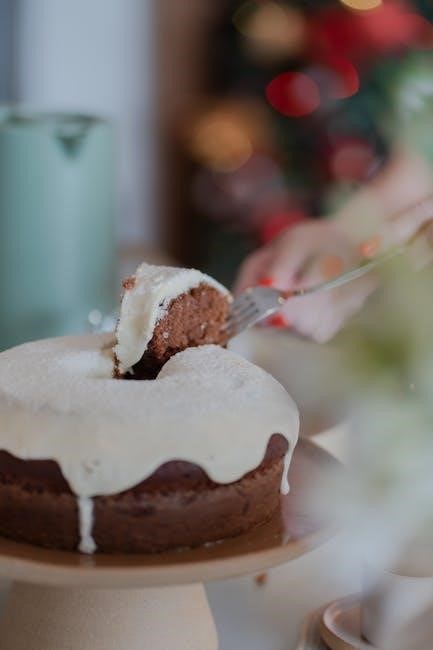
Tips for Perfect Cake Presentation
Ensure a polished look by serving cake at room temperature, avoiding crumbs, and using tweezers for final touches to create a professional presentation.
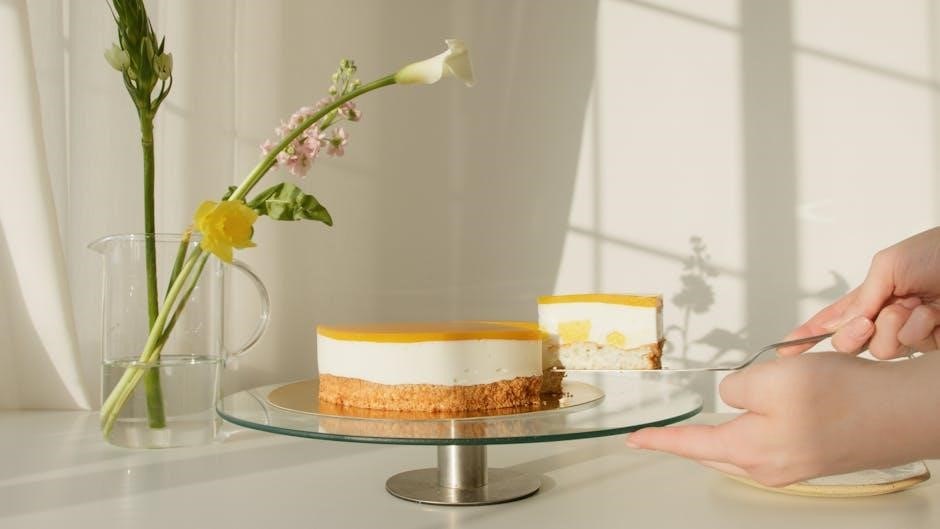
5.1 Serving Cake at the Right Temperature
Serving cake at the right temperature enhances both flavor and presentation. Most cakes are best served at room temperature, allowing the flavors to shine and the texture to remain light. However, chilling the cake briefly before cutting can help prevent frosting from smearing and make slicing easier. After cutting, let the slices warm up slightly to ensure a tender crumb and creamy frosting. Avoid serving cold cake, as it can feel dense and less flavorful. Balancing temperature ensures a perfect balance of taste and visual appeal for your guests.
5.2 Avoiding Crumbs and Smears

Avoiding crumbs and smears is key to a polished presentation. Use a serrated knife, as it creates cleaner cuts than a straight blade. Wipe the knife between slices to prevent frosting buildup. Lightly pressing the knife into the cake to mark slices before cutting can also help reduce crumbs. For extra precision, use a warm knife or dental floss to slice through cleanly. If smears occur, tweezers can be used to gently remove stray crumbs or frosting. These small steps ensure a neat, professional finish for your cake.
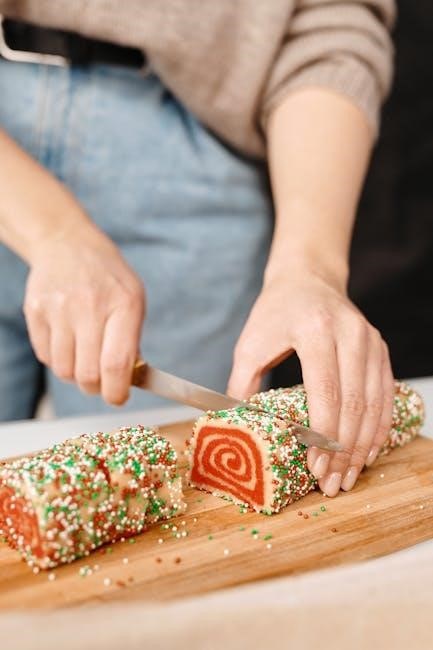
5.3 Using Tweezers for Final Touches
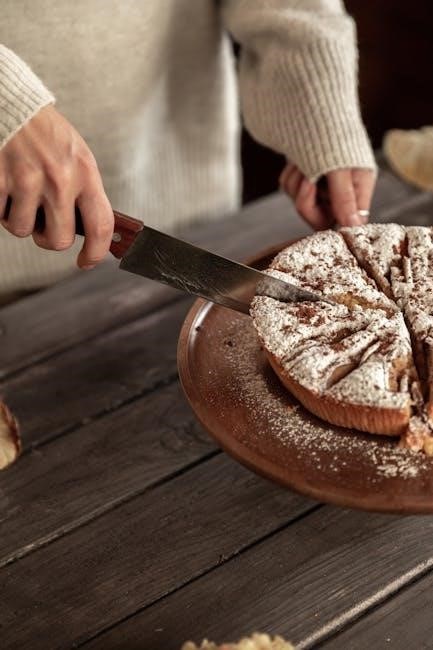
Tweezers are a handy tool for final adjustments. After slicing, use them to remove stray crumbs or frosting smudges. Gently pluck any misplaced bits to ensure each slice looks pristine. This detail-oriented step adds professionalism to your presentation, making even homemade cakes appear polished. Tweezers are especially useful for intricate designs or layered cakes. By fine-tuning the appearance, you create a visually appealing dessert that impresses both in taste and aesthetics. This small effort elevates the overall presentation, making it perfect for special occasions or professional settings.
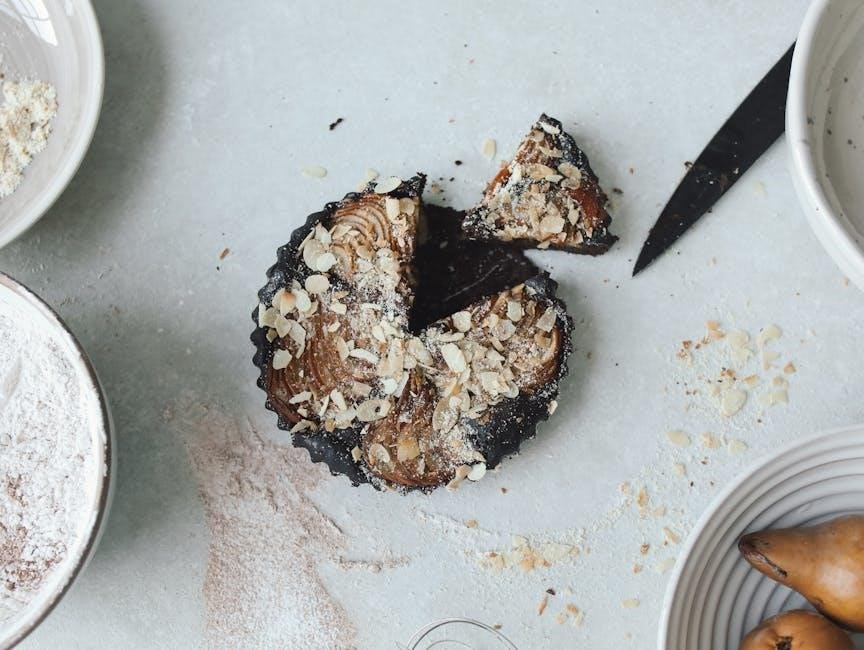
Printable Cake Cutting Guides
Printable cake cutting guides provide templates for round, square, and sheet cakes, ensuring even slices and perfect portion control. Customize charts for various serving sizes to suit any event.
6.1 Round Cake Serving Charts
Round cake serving charts are versatile tools for determining portion sizes. Available for cakes ranging from 4 to 16 servings, these charts ensure even slicing. They often include diagrams marking where to make cuts, helping you achieve uniform slices. Ideal for weddings or events, these guides can be customized based on serving size preferences. Printed charts are easy to share with caterers or clients, guaranteeing precise cuts. For best results, warm your knife before cutting and wipe it clean between slices to maintain neat, professional-looking portions. These charts are a must-have for flawless cake presentation and service.
6.2 Square Cake Serving Charts
Square cake serving charts provide a structured approach to cutting even portions. Available for cakes from 4 to 16 servings, these guides use grid lines to mark precise cutting points. This ensures uniform slices and professional presentation. Printable charts can be customized to fit your cake size and serving needs. They are ideal for events requiring consistent portion control. By following the chart’s guidelines, you can achieve clean, evenly sized slices. Pair with a serrated knife and warm blade for the best results, ensuring a polished finish for every occasion.
6.3 Customizable Cutting Templates
Customizable cutting templates offer flexibility for unique cake sizes and serving needs. Available for round, square, and sheet cakes, these templates can be adjusted to specify the number of slices and portion sizes. They often include markings for even spacing and symmetrical cuts. Users can print or digitally edit the templates to suit their requirements, ensuring precise and consistent results. Ideal for bakers and event planners, these templates streamline the cutting process, making it easier to achieve professional-looking slices every time. They are a practical solution for tailored cake presentations.